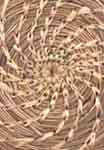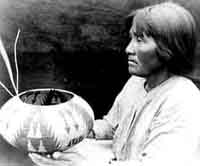 Mission Indian baskets Library of Congress, Prints and Photographs Division, LC-USZ62-98667 Curtis 1924 |
 Coiling with Artificial Sinew |
The technique used to stitch together or wrap coils will determine any surface texture and visible pattern. A variety of 'simple' stitches are usually used by Native Americans along the eastern seaboard of North America. Combinations of 'simple', 'intricate' and 'wrapping' stitches are often used by Native Americans in other areas.
 Lake Mono basket-maker Library of Congress, Prints and Photographs Division, LC-USZ62-118771 Curtis 1924 |
Simple stitches go around the bundle being added and then penetrate the former coil, only to be brought around the bundle being added again, repeated over and over. Simple stitches may be 'separate', 'interlocking', and 'split' in a variety of ways. Intricate stitches involve various knots made between the bundle or rod being added and the bundle below it, creating open spaces between coils. Wrapping stitches only go around the coil being added. Wrapping stitches do not penetrate previous coils and are often used in certain combination with intricate stitches to create a varied texture.
Using different dyed colors, tightly spaced simple stitches or wrapping stitches often hide the bundle or rod foundation, and create designs on a basket surface. Bundles of pine needles and sweet grass in Native American coil baskets were always left visible, using widely spaced simple stitches.
 Horsehair Basket | Native American techniques to splice in new stitching string vary not only from region to region, but also from one basketmaker to another. Unique splicing techniques are often the fingerprint of particular basketmakers. Some finely made baskets have well over one hundred thousand individual stitches! |
 Coiling begins on Bark Base |
 Coiling History and Background
Coiling History and Background
|
Eastern Pine Needle Baskets

|